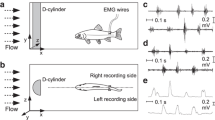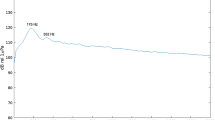Abstract
Trout commonly experience unsteady flows such as those caused by a stationary object exposed to running water. Instead of avoiding these flows, trout often use flow fluctuations for station holding. The behaviors associated with station holding are entraining, Kármán gaiting and bow wake swimming. We investigated the swimming behavior of trout in the vicinity of a stationary or moving 2-D shaped cylinder. To uncover the sensory modalities used for station holding, we studied the behavior of intact trout and of trout whose lateral line system was partially or totally impaired in the light or under infrared illumination. We also studied the activity of the axial red swimming muscles of entraining, Kármán gaiting and bow wake swimming trout and the neuronal processing of vortex information in the hindbrain of fish. Further studies showed that small motions of the caudal and/or pectoral fins are necessary to stay in preferred areas irrespective of the unsteadiness imposed by the wake of an object. Computational Fluid Dynamics simulations were carried out to uncover the forces that allow trout station holding with a minimum of energy expenditure.
Access this chapter
Tax calculation will be finalised at checkout
Purchases are for personal use only
Preview
Unable to display preview. Download preview PDF.
Similar content being viewed by others
References
Beckmann, M., Eros, T., Schmitz, A., Bleckmann, H.: Number and distribution of superficial neuromasts in twelve common European cypriniform fishes and their relationship to habitat occurrence. Intern. Rev. Hydrobiol. 95, 273–284 (2010)
Bleckmann, H.: Reception of hydrodynamic stimuli in aquatic and semiaquatic animals. In: Rathmayer, W. (ed.) Progress in Zoology, vol. 41, pp. 1–115. Gustav Fischer, Stuttgart (1994)
Bleckmann, H.: Peripheral and central processing of lateral line information. J. Comp. Physiol. A 194, 145–158 (2007)
Bleckmann, H., Breithaupt, T., Blickhan, R., Tautz, J.: The time course and frequency content of hydrodynamic events caused by moving fish, frogs, and crustaceans. J. Comp. Physiol. A 168, 749–757 (1991)
Blickhan, R., Krick, C., Breithaupt, T., Zehren, D., Nachtigall, W.: Generation of a vortex-chain in the wake of a subundulatory swimmer. Naturwissenschaften 79, 220–221 (1992)
Brücker, C., Bleckmann, H.: Vortex dynamics in the wake of a mechanical fish. Exp. Fluids, 799–810 (2007)
Chagnaud, B.P., Bleckmann, H., Engelmann, J.: Neural responses of goldfish lateral line afferents to vortex motions. J. Exp. Biol. 209, 327–342 (2006)
Chagnaud, B.P., Bleckmann, H., Hofmann, M.: Kármán vortex street detection by the lateral line. J. Comp. Physiol. A 193, 753–763 (2007)
Cook, C.L., Coughlin, D.J.: Rainbow trout Oncorhynchus mykiss consume less energy when swimming near obstructions. J. Fish Biol., 1–8 (2010)
Cooke, S.J., Thorstad, E.B., Hinch, S.G.: Activity and energetics of free swimming fish; insights from electromyogram telemetry. Fish Fisheries 5, 21–52 (2004)
Coombs, S., Janssen, J., Webb, J.F.: Diversity of lateral line systems: evolutionary and functional considerations. In: Atema, J., Fay, R.R., Popper, A.N., Tavolga, W.N. (eds.) Sensory Biology of Aquatic Animals, pp. 553–593. Springer, New York (1988)
Dijkgraaf, S.: The functioning and significance of the lateral line organs. Biol. Rev. 38, 51–106 (1963)
Enders, E.C., Boisclair, D., Roy, A.G.: The effect of turbulence on the cost of swimming for juvenile Atlantic salmon (Salmo salar). Can. J. Fish. Aquat. Sci. 60, 1149–1160 (2003)
Engelmann, J., Hanke, W., Bleckmann, H.: Lateral line reception in still- and running water. J. Comp. Physiol. A 188, 513–526 (2002)
Glauert, H.: Theoretical relationships for an aerofoil with hinged flap. Aero. Res. Cttee. R and M, 1095 (1927)
Kaus, S.: The effect of aminoglycoside antibiotics on the lateral line organ of Alocheilus lineatus (Cyprinodontidae). Acta Otolaryng (Stockh) 103, 291–298 (1987)
Kesel, A., Blickhan, R., Nachtigall, W.: Ablation of posterior lateral line organ. Does it effect steady swimming. In: Elsner, N., Singer, W. (eds.) Dynamics and Plasticity in Neuronal Systems, p. 265. Georg Thieme, Stuttgart (1989)
Klein, A., Bleckmann, H.: Determination of object position, vortex shedding frequency and flow velocity using artificial lateral line canals. Beilstein. J. Nanotechnol. 2, 276–283 (2011)
Kunze, S.: Untersuchungen zur Strömungs-Struktur Interaktion an dynamisch bewegten, flexiblen Oberflächen. Dissertation TU Freiberg, Freiberg (2011)
Kunze, S., Brücker, C.: Flow control over an undulating membrane. Exp. Fluids 50, 747–759 (2011)
Liao, J.C.: Neuromuscular control of trout swimming in a vortex street: Implications for energy economy during the Kármán gait. J. Exp. Biol. 207, 3495–3506 (2004)
Liao, J.C.: The role of the lateral line and vision on body kinematics and hydrodynamic preference of rainbow trout in turbulent flow. J. Exp. Biol. 209, 4077–4090 (2006)
Liao, J.C.: A review of fish swimming mechanics and behaviour in altered flows. Phil. Trans. R Soc. Lond. B 362, 1973–1993 (2007)
Liao, J.C., Beal, D.N., Lauder, G.V., Triantafyllou, M.S.: The Kármán gait: Novel body kinematics of rainbow trout swimming in a vortex street. J. Exp. Biol. 206, 1059–1073 (2003)
McHenry, M.J., Michel, K.B., Stewart, W., Müller, U.K.: Hydrodynamic sensing does not facilitate active drag reduction in the golden shiner (Notemigonus crysoleucas). J. Exp. Biol. 213, 1309–1319 (2010)
Mogdans, J., Bleckmann, H.: Peripheral lateral line responses to amplitude modulated hydrodynamic stimuli. J. Comp. Physiol. A 185, 173–180 (1999)
Montgomery, J., Coombs, S., Halstead, M.: Biology of the mechanosensory lateral line in fishes. Rev. Fish Biol. Fisheries 5, 399–416 (1995)
Montgomery, J.C., Macdonald, F., Baker, C.F., Carton, A.G., Ling, N.: Sensory integration in the hydrodynamic world of rainbow trout. Proc. R Soc. Lond. B (Suppl.), 195–197 (2003)
Münz, H.: Functional organization of the lateral line periphery. In: Coombs, S., Görner, P., Münz, H. (eds.) The Mechanosensory Lateral Line Neurobiology and Evolution, pp. 285–298. Springer, New York (1989)
Northcutt, R.G.: The phylogenetic distribution and innervation of craniate mechanoreceptive lateral lines. In: Coombs, S., Görner, P., Münz, H. (eds.) The Mechanosensory Lateral Line Neurobiology and Evolution, pp. 17–78. Springer, New York (1989)
Palmer, L.M., Giuffrida, B.A., Mensinger, A.F.: Neural recordings from the lateral line in free-swimming toadfish, Opsanus tau. Biol. Bull. 205, 216–218 (2003)
Popper, A.N., Fay, R.R., Platt, C., Sand, O.: Sound detection mechanisms and capabilities of teleost fish. In: Collin, S.P., Marshall, N.J. (eds.) Sensory Processing in Aquatic Environments, pp. 3–38. Springer, Heidelberg (2003)
Przybilla, A.: The swimming behavior of rainbow trout, Oncorhynchus mykiss, in turbulent water flow, p. 257. Dissertation. Faculty of Mathematics and Natural Sciences. University of Bonn, Bonn (2012)
Przybilla, A., Kunze, S., Ruder, A., Bleckmann, H., Brücker, C.: Entraining trout: A behavioural and hydrodynamic analysis. J. Exp. Biol. 213, 2976–2986 (2010)
Schmitz, A., Bleckmann, H., Mogdans, J.: Organization of the superficial neuromast system in goldfish, Carassius auratus. J. Morphol. 269, 751–761 (2008)
Sutterlin, A.M., Waddy, S.: Possible role of the posterior lateral line in obstacle entrainment by brook trout (Salvelinus fontinalis). J. Fish Res. Bd. Canada 32, 2441–2446 (1975)
Taguchi, M., Liao, J.C.: Rainbow trout consume less oxygen in turbulence: the energetics of swimming behaviors at different speeds. J. Exp. Biol. 214, 1428–1436 (2011)
Vogel, S.: Life in moving fluids. The physical biology of flow. Princeton University Press, Princeton (1983)
Wullimann, M.F.: The central nervous system. In: Evans, D.H. (ed.) The Physiology of Fishes, pp. 245–282. CRC Press, New York (1998)
Yang, Y., Klein, A., Bleckmann, H., Liu, C.: Atrificial lateral line canal for hydrodynamic detection. Applied Physics Letters 99, 023701 (2011)
Author information
Authors and Affiliations
Corresponding author
Editor information
Editors and Affiliations
Rights and permissions
Copyright information
© 2012 Springer Berlin Heidelberg
About this chapter
Cite this chapter
Bleckmann, H., Przybilla, A., Klein, A., Schmitz, A., Kunze, S., Brücker, C. (2012). Station Holding of Trout: Behavior, Physiology and Hydrodynamics. In: Tropea, C., Bleckmann, H. (eds) Nature-Inspired Fluid Mechanics. Notes on Numerical Fluid Mechanics and Multidisciplinary Design, vol 119. Springer, Berlin, Heidelberg. https://doi.org/10.1007/978-3-642-28302-4_10
Download citation
DOI: https://doi.org/10.1007/978-3-642-28302-4_10
Publisher Name: Springer, Berlin, Heidelberg
Print ISBN: 978-3-642-28301-7
Online ISBN: 978-3-642-28302-4
eBook Packages: EngineeringEngineering (R0)




